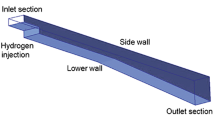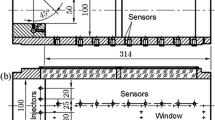Summary
In two previous papers the unstable combustion of premixed gases was studied assuming there to be no heat transfer in the burner ports. Generally, however, the walls of the burner ports are rather hot, so that the fluctuating flow through them induces a fluctuating heat transfer from their hot walls to the gas. This effect may influence the stability of the combustion and is therefore studied in the present paper. The fluctuating heat transfer in the burner ports and especially the fluctuations in the temperature of the gas at the exit of the burner ports are related to the fluctuations in velocity by means of transfer functions. The quasi-steady parts of these transfer functions are calculated for fully established flow and varying wall temperature. The complete transfer functions are only calculated for uniform flow through the burner ports. The characteristic equation accounting for heat transfer in the burner ports is derived on the assumptions that the Mach numbers are very low and that the length of the flames is very short. The theory is applied to a simple model of the flow system in the low-frequency region. Some effects induced by the heat transfer in the burner ports are discussed.
Similar content being viewed by others
Abbreviations
- A :
-
area of cross-section
- B :
-
\(c_{p,2} \bar T_2 /(c_{p,1} \bar T_1 )\).
- B*:
-
B/Γ
- C :
-
acoustic capacitance
- c p :
-
heat capacity of gas per unit mass at constant pressure
- G s :
-
R s /(ωL s )2
- i :
-
volume flow (=UA)
- I 0 :
-
hyperbolic or modified Bessel function of zero order
- j :
-
\(\sqrt { - 1.}\)
- L :
-
acoustic inductance
- l b :
-
length of the burner ports
- \(\bar m\) :
-
mean value of the mass flow through the burner ports
- N T :
-
temperature coefficient defined by (5,2)
- n :
-
exponent defined by (5,1)
- O :
-
symbol of Bachmann-Landau
- P :
-
pressure
- P e :
-
Péclet number (=(Ū b ) av r b /ε b )
- Q :
-
G s /(ω 1 C 2)
- Q b :
-
heat delivery to gases in burner ports per unit time
- Q f :
-
heat released by the flames per unit time
- q b :
-
\(Q_b '/\bar Q_b .\)
- q f :
-
\(Q_f '/\bar Q_f .\)
- R :
-
acoustic resistance
- r :
-
radial distance from the axis of the burner port
- r b :
-
radius of the burner port
- s :
-
Laplace parameter
- s b :
-
reduced fluctuations in N.C.V. defined in part III by (3,14)
- T :
-
temperature
- T r :
-
transfer function
- t :
-
time
- U :
-
axial velocity
- u :
-
(U b ′) av /(Ū b ) av
- w :
-
ωl b /(Ū b ) av
- x :
-
co-ordinate along the axis of the burner port measured from its entrance
- Y :
-
acoustic admittance
- Z :
-
acoustic impedance
- γ :
-
ratio of specific heat capacities
- Γ :
-
dimensionless number defined in part III by (3,30)
- Γ(n):
-
gamma function
- ε :
-
thermal diffusivity of gas
- η :
-
r/r b
- ϑ :
-
(T′) av /(\(\bar T\)) av
- Θ :
-
Graetz solution defined by (5,27) and (5,28)
- λ b :
-
l b /(r b Pe)
- Λ :
-
\((B^* - 1) \chi T{\text{ }}\dot Tr_\vartheta ,u^{(s)} .\)
- ξ :
-
x/(r b Pe)
- ρ :
-
density
- τ b :
-
l b /(Ū b ) av
- τ c :
-
time lag of chemical and physical processes in the flame zone
- τ f :
-
time lag defined in part III by (A, 6)
- v b :
-
U b /(Ū b ) av
- ϕ :
-
C 1/C 2
- Φ :
-
\(\bar Q_b /\bar Q_f .\)
- Χ T :
-
temperature coefficient of N.C.Y. defined in part III by (3,21)
- ψ :
-
(ω 1/ω 2)2
- Ψ :
-
reduced temperature defined by (5,24)
- ω :
-
circular frequency
- ω*:
-
ωr /2 b /ε b
- \(\tilde \omega\) :
-
ω 1 τ f
- ω 1 :
-
resonance frequency of Helmholtz resonator upstream of the flames
- ω 2 :
-
resonance frequency of Helmholtz resonator downstream of the flames
- 1:
-
mixing tube or mixing chamber
- 2:
-
flame tube or flame chamber
- av :
-
averaged over cross-section of burner port (velocity), or mixed mean value (temperature, see (5,5))
- b :
-
burner port
- cr :
-
critical value
- e :
-
exit of burner port
- L :
-
Laplace transform
- n :
-
temperature of gas corresponding to the wall temperature given by (5,21)
- q b :
-
heat delivery in burner port
- q b :
-
heat delivery by flames
- s :
-
stack
- u :
-
velocity in burner port
- w :
-
wall of burner port
- ϑ :
-
temperature of gas at the exit of the burner port
- (-):
-
mean value (averaged over time)
- ()′:
-
fluctuating part
- ()(s) :
-
quasi-steady part
References
Merk, H. J., Appl. Sci. Res. A7 (1958) 175.
Merk, H. J., Appl. Sci. Res. A7 (1958) 192.
Klein, J., and M. Tribus, Trans. Amer. Soc. Mech. Engrs. 78 (1956) 441.
Klein, J. and M. Tribus, Heat Transfer Symposium, Engng. Res. Inst., Univ. Michigan, 1953, pp. 211–235.
Sellars, J., M. Tribus, and J. Klein, Trans. Amer. Soc. Mech. Engrs. 78 (1956) 441.
Jakob, M., Heat Transfer I, New York, 1949, pp. 451–464.
Schenk, J. and J. M. Dumoré, Appl. Sci. Res. A4 (1953) 39.
Merk, H. J., Sixth Symposium on Combustion, New York, 1957, p. 500.
Frazer, R. A. and W. J. Duncan, Proc. Roy Soc. London A124 (1929) 642.
Author information
Authors and Affiliations
Rights and permissions
About this article
Cite this article
Merk, H.J. Analysis of heat-driven oscillations of gas flows. Appl. sci. Res. 8, 1–27 (1959). https://doi.org/10.1007/BF00411735
Received:
Issue Date:
DOI: https://doi.org/10.1007/BF00411735




